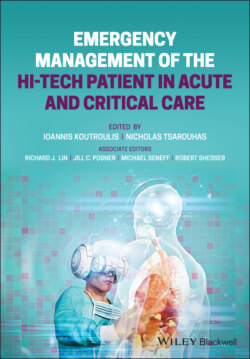Читать книгу Emergency Management of the Hi-Tech Patient in Acute and Critical Care - Группа авторов - Страница 86
Air Embolism and Other Rare Complications
ОглавлениеWhile rare, air embolism is a potentially fatal complication of CVCs with which ED practitioners must be familiar. A patient with CVC‐associated air embolism may demonstrate acute‐onset chest pain, dyspnea, hypotension, tachycardia, dizziness, and anxiety. Because such patients may progress to loss of consciousness and cardiac arrest, ED providers suspecting air embolus must act quickly to prevent further air entry into the CVC circuit. Externalized catheters should be clamped immediately, and the patient should be placed in Trendelenburg in the left lateral decubitus position to trap any air bubbles in the right ventricle. Patients with suspected air embolus should be put on 100% supplemental oxygen, and alternate IV access should be obtained as quickly as possible. To prevent air emboli, patients, their care providers, and all ED personnel must keep the externalized portion of any indwelling CVC clamped whenever the line is not actively in use. Finally, because the proximal tip of most CVCs terminates at the SVC‐RA junction, it is important to note that fracture or migration of an indwelling line can lead to other rare intrathoracic complications, including cardiac arrhythmia, cardiac tamponade, or – more commonly during catheter placement – pneumothorax or hemothorax. Patients presenting with these complications are unlikely to implicate the CVC in their chief complaint, so it is incumbent upon the ED provider to have a high index of suspicion in screening for them.
